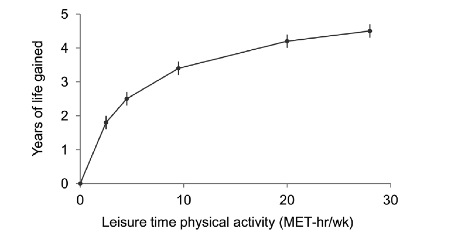Exercise & Longevity
People exercise for all sorts of reasons including being in better shape to meet the challenges of daily life, weight control, general health, being able to keep up with their kids and grandkids, and participation in competitive activities. But what is the long term payoff in terms of extra years lived or longevity? There is some fascinating new information on the question that comes from a pooled evaluation of a number of large studies conducted over many years by the National Cancer Institute on lifestyle and health in about 650,000 people.
There was enough data in these studies on physical activity and things like BMI to do rigorous statistical analysis on a couple of questions. First the authors had to divide the subjects into groups based on how much physical activity they got per week. The used something called “Met Hours”. A met is a marker of how much oxygen you use per minute at rest and reflects your energy consumption. Brisk walking takes about 3 mets. During peak exercise healthy lean people in their twenties who are untrained max out at about 10-12 mets when they are tested on a treadmill. Without training these peak values fall perhaps 10% per decade starting in our 30s. Elite athletes can achieve max values of 15-20 mets.
The paper categorized people into six activity groups equal to brisk walking for 0, 1–74, 75–149, 150–299, 300–449, and 450+ minutes per week. In terms of “met hours per week”, these walking categories equal 0, 0.1–3.74, 3.75–7.4, 7.5–14.9, 15.0–22.4, and more than 22.5. Most public health guidelines suggest that 150-299 minutes of moderately vigorous exercise (7.5 to 14.9 met hours) are a key for good health and significantly reduce the risk of things like diabetes and heart disease. The figure below shows the longevity findings.
The authors of the study concluded that:
…..adding even low amounts of leisure time physical activity to one’s daily routine—such as 75 min of walking per week—may increase longevity. This finding may help convince currently inactive persons that a modest physical activity program is “worth it” for health benefits, even if it may not result in weight control. Physical activity above the minimal level—at recommended levels, or even higher—appears to increase longevity even further, with the increase in longevity starting to plateau at approximately 300 min of brisk walking per week. Finally, a lack of leisure time physical activity when combined with obesity is associated with markedly diminished life expectancy. Together, these findings reinforce prevailing public health messages and support them for a range of ages and backgrounds: both a physically active lifestyle and a normal body weight are important for increasing longevity.”
There is not much to add to this except that people who are active also have more disability free years at the end of life. Thus the active live both longer and are more independent as they age with fewer chronic medical problems.
This entry was posted on Monday, November 12th, 2012 at 10:38 am and is filed under Research and Health. You can follow any responses to this entry through the RSS 2.0 feed. You can leave a response, or trackback from your own site.


